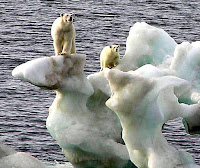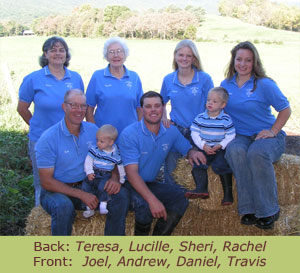
On Thursday, February 3rd, Dr. Donald Perovich came to talk to our class in the Savannah room. Dr. Perovich is a geophysicist who studies sea ice and its interactions with sun light. I am in both APES and Climat Science that I had the pleasure of seeing the presentation twice. I feel that even though the information was the same both times the first time through Dr. Perovich was more humores and had a better all around presentation. He told more stories and shared more of his experiences making it more personal and easier to connect to.
 |
| Dr. Perovich's picture from the Dartmouth website. |
 |
| Dr. Perovich on one of his explorations. |
There will always be ice in the winter because it is dark for months at a time and it gets so cold that the ocean freezes over completely, but in the summer when there is more direct sunlight and it is light out of longer the ice starts to melt due to climate change. The world is getting warmer, it is a fact and there are signs all around us. One of the greatest proxies that help us see climate change is sea ice. There are lots of ways to measure sea ice but the curent method of choice is satellites because they can work day and night through all weather.
 By looking at satellite measurement of sea ice through all moths it is hard to see a signal through all the noise so to simplify things Dr. Perovich showed us a chart of just the amount of sea ice coverage in the month of September. Looking at these numbers is much more reasonable and it is easier to see what is happening. Dr. Perocich told us that there is a 9% decrees in the amount of September sea ice per decade. In 1960 there were 7.8 million square kilometers of sea ice and in 2007 there were just 4.2 million square kilometers witch is a drastic difference. Plainly put Dr. Perovich told us: "observations show sea ice is melting."But what about the future? Models are showing a lot of different predictions but one answer we were given was that there will be no more summer ice in 2100.
By looking at satellite measurement of sea ice through all moths it is hard to see a signal through all the noise so to simplify things Dr. Perovich showed us a chart of just the amount of sea ice coverage in the month of September. Looking at these numbers is much more reasonable and it is easier to see what is happening. Dr. Perocich told us that there is a 9% decrees in the amount of September sea ice per decade. In 1960 there were 7.8 million square kilometers of sea ice and in 2007 there were just 4.2 million square kilometers witch is a drastic difference. Plainly put Dr. Perovich told us: "observations show sea ice is melting."But what about the future? Models are showing a lot of different predictions but one answer we were given was that there will be no more summer ice in 2100.  |
| Measuring Albedo's |
One phenomenon that helps to explain the warming, that the Dr. talked a lot about, is the Albedo Feedback. An Albedo is the amount of sunlight that is being reflexed back 0 being the lowest and 1 the highest. Ice is the surface with the highest Albedo at about 85% and snow has the lowest with just 7%. This is important because this positive feedback(Input= sunlight, ocean area and ocean albedo, Output= sunlight absorbed by the ocean) loop amplifies change. "Over the past 27 years there is an 85% increase in solar heat impact."While the Albedo feedback is very interesting the loss of sea ice is not just an intellectual problem there are lots of other consequences such as the changing ecosystem and the amount of shipping up north.
 The state of the arctic is declining with the loss of the summer sea ice. The rich ecosytem witch is home to many animals such as polar bears, seal, and beluga whales is quickly changing and not for the better. With less sea ice the polar bears habitat and hunting ground is being quickly diminished. For the seals there is less year round ice witch means that not a lot of snow has the opportunity to stick so there is no where for the seals to build there dens to keep there young warm and safe. The belugas are being impacted by the increased shipping and the loss of krill witch feed off of algae that grows on the underside of the ice witch is no longer there. The shipping is increasing because with no ice it is quick 12,900 km along the northern sea route from Europe to Asia apposed to taking the Suz Canal witch is 20,900km though some dangerous territory.
The state of the arctic is declining with the loss of the summer sea ice. The rich ecosytem witch is home to many animals such as polar bears, seal, and beluga whales is quickly changing and not for the better. With less sea ice the polar bears habitat and hunting ground is being quickly diminished. For the seals there is less year round ice witch means that not a lot of snow has the opportunity to stick so there is no where for the seals to build there dens to keep there young warm and safe. The belugas are being impacted by the increased shipping and the loss of krill witch feed off of algae that grows on the underside of the ice witch is no longer there. The shipping is increasing because with no ice it is quick 12,900 km along the northern sea route from Europe to Asia apposed to taking the Suz Canal witch is 20,900km though some dangerous territory.  |
| The boat from his year long trip. |
Every point is precious
Every point is precious
Every datum true
We make observations
And send them home to you
I measure albedo
Sunlight up and down
I catch every photon
Before they hit the ground
Dancing little snowflakes
Falling from the sky
In the name of science
Yellow you must die
Every point is precious
Every datum true
And send them home to you
I measure the meltponds
as they grow so deep
If they don't freeze over
soon we all shall weep
Each stake's truly revered
The pious gauges loved
We tend to the sacred
Ground in which they're shoved
Every point is precious
Folks, we lose a few
We need help with data
Can we count on you
Photos from:
http://www.crrel.usace.army.mil/sid/personnel/perovich.donald.html
http://engineering.dartmouth.edu/faculty/regular/donaldperovich.html
http://www.crrel.usace.army.mil/sid/perovich/SHEBAice/index.htm
http://inhabitat.com/life-preservers-for-polar-bears/











































